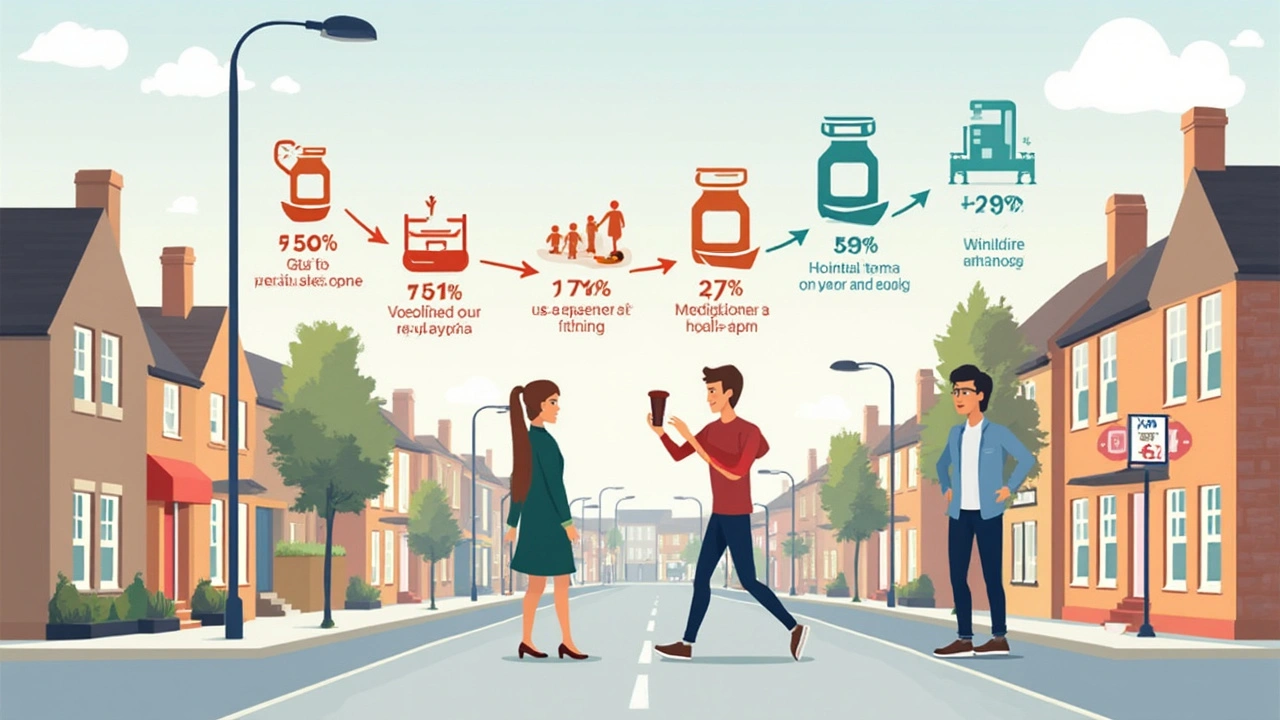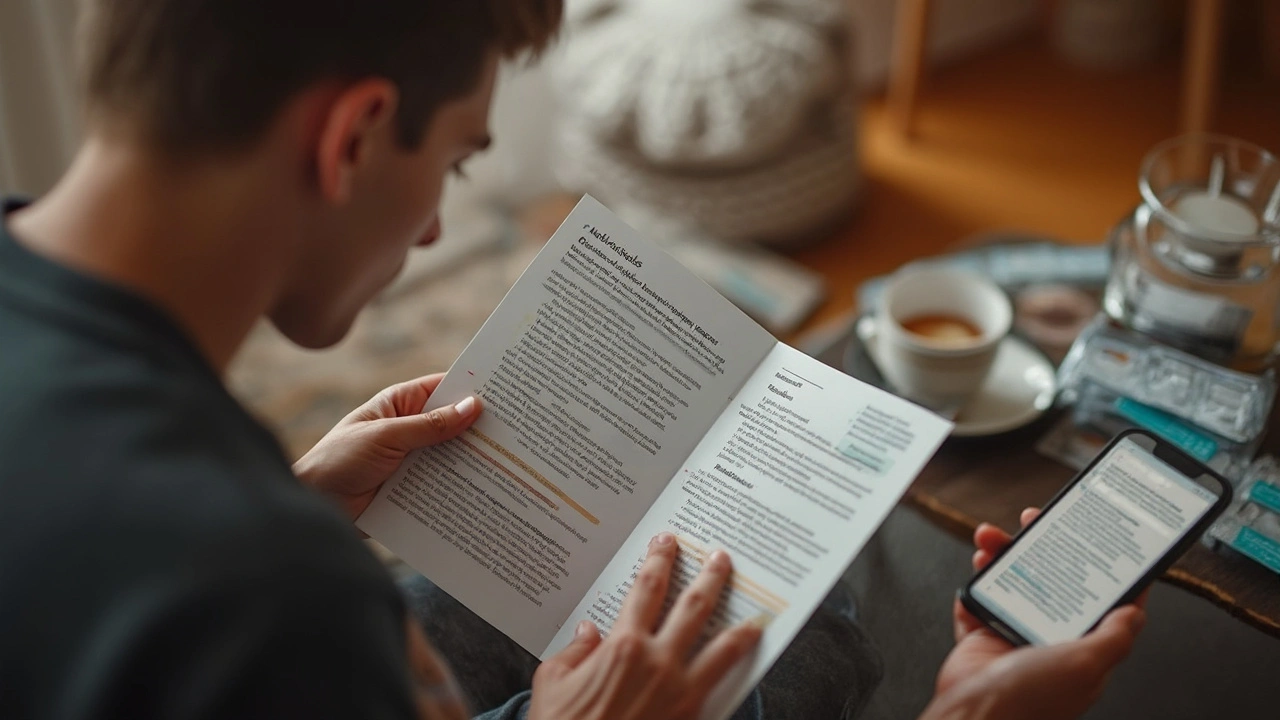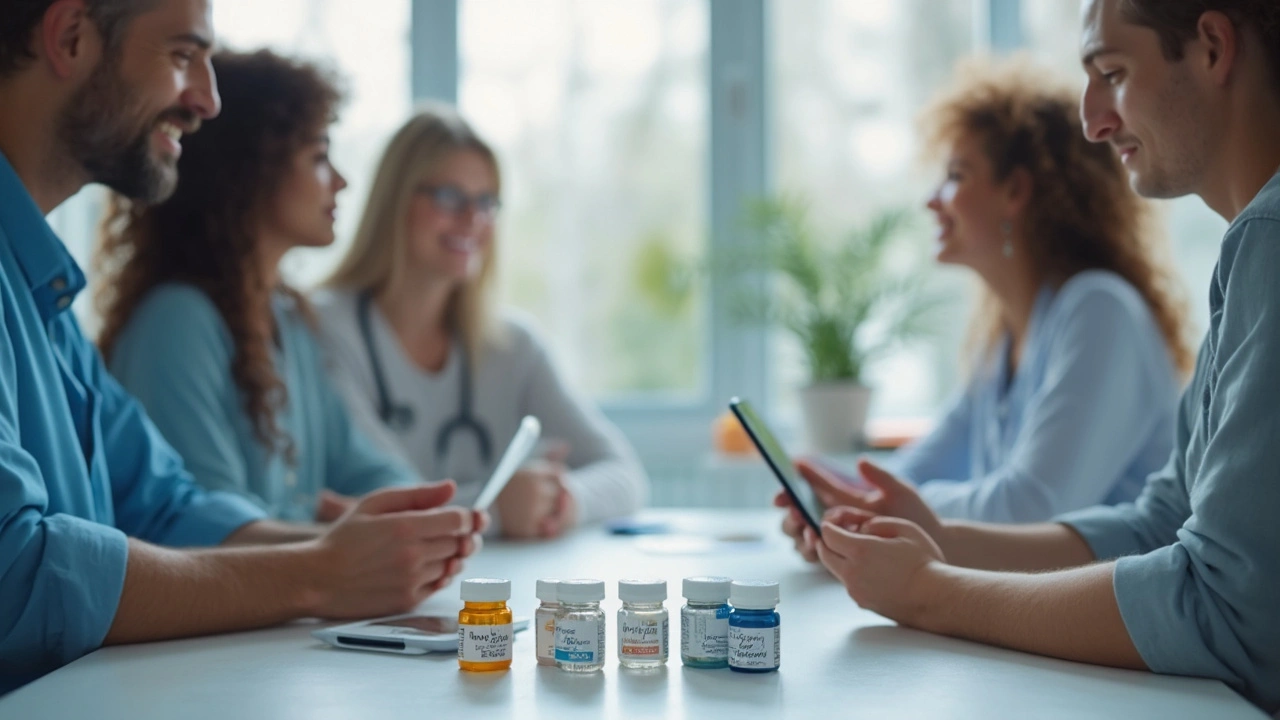If you’ve ever watched someone struggle with alcohol, you’ve probably heard about Antabuse. It’s been around since the 1950s, almost legendary for making people sick if they drink. But here’s the wild part—most people just stop taking it when cravings hit. Sobriety isn’t just about willpower and consequences anymore. There’s a new generation of meds aiming for something bigger: dulling the urge, not just policing it.
Naltrexone: Blocking the Buzz, Not Just the Bottle
Naltrexone’s story deserves a spotlight. First used for opioid addiction, it found an unlikely second act in treating heavy drinking. The science is refreshingly direct: naltrexone blocks endorphins in your brain, blunting alcohol’s pleasure spike. You don’t get that euphoric kick anymore. So, people just… lose interest. The numbers back it up: studies from institutions like the National Institute on Alcohol Abuse and Alcoholism have shown that naltrexone can reduce heavy drinking days by up to 35% in some patients. That’s not just theory—it’s families getting their weekends back, job stability, relationships patching up.
There’s flexibility too. Some folks do well on daily pills. Others use the depot shot—one jab, and you’re covered for a month. That’s a game changer for forgetful types. It gives clinicians and patients power to choose. The side effects? Usually mild. Nausea, headaches, fatigue… nothing most people can’t handle. And unlike Antabuse, you can slip up, have a drink, and not end up in the ER.
Here’s a detailed comparison in table format:
| Medication | How It Works | Dose Forms | Best Use Case | Key Side Effects | Success Rate* |
|---|---|---|---|---|---|
| Antabuse (disulfiram) | Causes sickness if alcohol consumed | Pill | Excellent for highly motivated abstainers | Nausea, vomiting, headache, liver toxicity | Low adherence, <20% stay on long-term |
| Naltrexone | Blocks alcohol reward pathways | Pill, depot injection | Reduces cravings, allows harm reduction | Nausea, fatigue, rare liver effects | 25-35% report reduction in heavy drinking |
| Acamprosate | Balances brain signals post-alcohol use | Pill | Supports abstinence, especially post-detox | Diarrhea, anxiety, insomnia | ~20% increase in abstinence rates |
*Success rates based on various clinical studies, results can vary widely.
Naltrexone’s popularity keeps growing, not least because it welcomes people who aren’t ready to swear off booze completely. Drink less, relapse less. Just don’t expect miracles after a few pills—behavior change takes time, but many clients notice the edge dull after two to four weeks.
What about insurance? Most provincial plans in Canada and many US plans now fund naltrexone—sometimes you still need a doctor’s persistent letter, especially for the expensive shot, but don’t let paperwork scare you off. If you’re wondering about other alternatives to antabuse, check this resource: alternatives to antabuse. It’s a handy jump-off point as you explore what could actually work, especially if you’ve hit a wall with the old approaches.

Acamprosate: Rebuilding Your Brain’s Calm
Here’s the underdog—acamprosate. It doesn’t get flashy ads or breathalyzer drama, but its science is fascinating: when you drink for years, your brain rewires itself to expect alcohol, shifting neurotransmitters (especially GABA and glutamate). When you stop, your system goes haywire—think anxiety, insomnia, even mild tremors. Acamprosate helps restore balance so withdrawal is smoother and cravings shrink.
No, it won’t get you drunk or high. It quietly reduces the urge to pick up a drink, especially in those already working on quitting. The big win? Studies published in journals like JAMA report abstinence rates up to 20% higher than placebo after six months. For someone in early recovery, that’s life-changing. But let’s get real: it’s a hassle to take. Typical dosing is two pills, three times a day. Miss doses, and its effectiveness drops.
Side effects tend to be stomach issues—diarrhea and bloating top the list. It’s pretty tame compared to Antabuse, though. Also, acamprosate is kidney-cleared, not liver-cleared. If you have a damaged liver from heavy drinking (super common), acamprosate is often the safest choice. Canadian and European docs lean on it heavily for people post-detox, especially if relapse anxiety is sky-high.
Some useful tips if you’re considering acamprosate:
- Set alarms or use a pillbox—six pills a day is easy to mess up.
- Start as soon as you’ve detoxed or stopped drinking—waiting too long lowers its benefits.
- Pair with therapy. Meds take the edge off, but groups or counseling boost success rates dramatically.
- If pills are tough, talk to your doctor about other options—you need something you’ll actually take.
Some pharmacies in Toronto offer blister packs to organize multi-dose meds—worth asking your pharmacist.

Emerging Treatments: What’s on the Horizon?
Sometimes it feels like the same few medications just get rotated. Yet research is quietly moving fast. There’s a fresh roster of experimental options (and off-label uses) transforming alcohol treatment:
- Topiramate: Originally for epilepsy, topiramate is now a low-key star in alcohol studies. It works by calming your brain’s excitability, which can cut cravings. A big trial found topiramate helped people reduce heavy drinking by around 30%. Watch out for cognitive side effects (some folks get word-finding trouble or tingling). Still, if naltrexone or acamprosate don’t work, this could be your next step.
- Gabapentin: Better known for nerve pain, gabapentin’s role in alcohol withdrawal is gaining traction. It calms nerves, reduces post-quit insomnia, and seems to blunt cravings for many. For those with low-level withdrawal symptoms, gabapentin might be used short-term or even as maintenance, especially when paired with therapy.
- Baclofen: Used a lot in Europe, baclofen targets muscle relaxers but also influences cravings. It’s sometimes used off-label for severe alcohol use disorder when other meds fail, though data is still catching up.
- Kudzu extract & supplements: These aren’t mainline treatments but have popped up in some studies as weak craving suppressants. Don’t expect miracles, but it shows how hungry people are for new options.
Out of left field, there’s even research into psychedelic-assisted therapy (like psilocybin), which aims to reset addictive patterns in small study groups. It’s not a daily med—and it’s definitely not available widely—but Toronto and Vancouver have early trials going. The same for deep brain stimulation and digital therapeutics—think smartphone-based cognitive therapies that offer on-the-go support, nudging users in real time when cravings hit.
But let’s be honest: no single pill fixes everything. Success comes from fit—finding what clicks with your brain, your habits, your motivation. That could be classic Antabuse for a stubborn streak, or newer meds with fewer threats attached. What really matters is being open to trying what’s next, even after a false start or two.
Curious how these options stack up at a glance? Here’s a quick table for comparison:
| Newer Option | Advantages | Drawbacks | Availability in Canada |
|---|---|---|---|
| Topiramate | Lowers heavy drinking rates, not liver-toxic | Cognitive side effects, slow dose ramp-up | Off-label use, by prescription |
| Gabapentin | Reduces mild withdrawal/anxiety, helps sleep | Drowsiness, dependency risk | Off-label, accessible with doctor approval |
| Baclofen | May block cravings, safe for liver disease | Drowsiness, muscle weakness, less evidence | Limited, sometimes via special access |
| Psychedelic therapy | Potential for lasting behavioral shift | Experimental, strict research settings only | Pilot trials in select clinics |
Always talk to a doc or addictions specialist—Canadian laws and pharmacy rules change quickly. In Toronto, most teaching hospitals have Addiction Medicine teams that know the latest protocols, and virtual consults keep things private if that’s a concern.
Here’s a pro tip: even if you don’t want strict abstinence, new medications like naltrexone and topiramate are designed for harm reduction—they fit real life, not fantasy scenarios. If shame from past failed attempts haunts you, let it go. The science—and options—have changed. The new question isn’t “why can’t I just stop?” but “what could make it easier to change my story this time?”


Greg DiMedio
July 18, 2025 AT 07:39Seriously, the treatment landscape for alcohol dependence these days looks like a confusing buffet with too many options and none quite as exciting as you’d hope. Antabuse was the OG, but now with naltrexone and acamprosate thrown into the mix, it feels like a pharma arms race to find the one that actually sticks.
From what I gather, naltrexone kind of blocks the buzz while acamprosate supposedly soothes the brain’s craving pathways. Sounds fancy, but isn’t everyone just swapping one disappointment for another at the end of the day? I mean, personal success stories are great but what about the massive number of folks who drop off the wagon anyway?
And let's not pretend side effects aren’t a thing – each of these meds carries a baggage claim.
Honestly, I’d love to hear if anyone’s really had their life changed by one of these alternatives because I’m tired of all the hype and mixed marketing.
Badal Patel
July 19, 2025 AT 20:33Oh my goodness!!! The sheer complexity of these so-called "modern treatments" is truly mind-boggling... and I find it utterly hilarious how everyone seems to think popping pills can magically cure what is a deeply human and psychological struggle.!!!
Antabuse, naltrexone, acamprosate – must we delve into pharmaceutical jargon or should we acknowledge the elephant in the room?!!!
Seriously, why is medical science pretending that a tiny pill can address years of trauma, behavioral patterns, and societal pressures?!!! It’s laughable, I tell you, Laughable!!!
And what happened to proper therapy, community support, and real human connection?!!! These should be the cornerstones, not some chemical band-aid marketed to desperate patients.!!!
Epic fail of modern medicine if you ask me!!!!!
KIRAN nadarla
July 21, 2025 AT 09:21Firstly, let me correct a glaring error in your phrasing here: it's 'acamprosate' not 'acamprosat'. Precision matters when discussing treatments. Treating alcohol dependence is a matter of both science and linguistics, apparently.
Onto the real issue – naltrexone’s efficacy varies widely, and the literature shows mixed outcomes. The article’s comparison of side effects was rather superficial, in my opinion. For instance, it failed to differentiate the neurochemical pathways affected by these drugs.
Moreover, the success rates you mentioned need contextualization; that is, they must be framed within controlled studies vs real-world application, which isn’t always the same thing. It's a pity the article didn't explore this nuance.
Side note: why do so many people still cling to Antabuse when data has shown it's quite limited and with severe compliance issues? That's an interesting paradox.
Kara Guilbert
July 22, 2025 AT 13:50Honestly, I find it disturbing that reliance on these replacements like naltrexone and acamprosate is becoming the norm instead of focusing on holistic recovery. You can't just shove a pill down someone's throat and expect moral transformation.
Alcohol dependence is not merely a biochemical puzzle, but a symptom of deeper psychological, social, and spiritual malaise.
Modern medicine seems eager to gloss over these realities in the name of quick fixes, and I can't stand for it. We should be advocating for values and personal responsibility, not just medicalized solutions.
It's about the human will to resist, not some drug-induced numbness to cravings.
Sonia Michelle
July 23, 2025 AT 16:00I appreciate this article for shedding light on alternatives beyond Antabuse, which many find difficult due to its unpleasant reactions when drinking.
Naltrexone and acamprosate have shown promising results for many, especially when integrated with counseling and support groups.
The way this article breaks down the pros and cons helps readers understand which medication might best fit their personal needs or those of loved ones.
Because treatment is never one-size-fits-all.
Moreover, newer options mentioned demonstrate how the field continues evolving toward more effective and tolerable treatments. It gives hope, which is crucial.
I'm curious, has anyone tried these alternatives and felt a meaningful change?
Neil Collette
July 24, 2025 AT 20:58Oh joy, another article pretending we can solve centuries-old human weaknesses with pills. Bravo.
Naltrexone cuts the buzz, so you don't get joy but suffer through withdrawal. Acamprosate calms the brain, but really, you might as well accept misery as the price for abstinence.
Real talk though, these meds are band-aids wrapped in marketable promises.
Plus, the side effects? Sure, the article mentions them but glosses over how debilitating they can be. Anyone who says treatment is comfortable is lying to themselves or you.
If it doesn’t fundamentally change your relationship with alcohol, what’s the point? Keep that in mind when you chase the magic pill.
James Lee
July 26, 2025 AT 01:43Honestly, I find these so-called "new options" to be just slight variations on a tired theme. The article does a decent job outlining them but the bigger philosophical question remains: Are we treating symptoms or root causes?
The pharmaceutical dance here reminds me of a pseudo-philosophical debate — chasing shadows trying to cage a beast with chemistry rather than understanding the human condition at its core.
In the end, the article fails to address the necessity of addressing societal, emotional, and existential factors that drive dependency.
Where is the discourse on meaning and purpose in recovery? That's the real work folks need, not just naltrexone versus acamprosate.
Dennis Scholing
July 27, 2025 AT 06:36This is a valuable resource for anyone seeking clarity on treatment options. The breakdown of different medications' mechanisms and side effects equips patients and caregivers with knowledge crucial for informed decisions.
Importantly, combining pharmacological aids with counseling and social support tends to yield the best outcomes.
The article’s practical tips and data-driven approach foster understanding rather than fear or skepticism. It's refreshing to see evidence-based content presented accessibly.
For those stepping into recovery, having such information demystifies the process and empowers choices aligned with personal and medical needs.
Kasey Lauren
August 4, 2025 AT 11:33Glad to see some hopeful options out there! I think it’s really important to remember that recovery isn’t just about meds, but about finding hope and support. Sometimes just knowing there are different paths can make a big difference.
I like that this article talks about real-world success and personal insights — that kind of connection helps people feel less alone.
If anyone is struggling, I encourage them to keep exploring and reach out for help. Progress might be slow, but every step forward counts.
Small victories matter, and having treatments that fit individual needs can be a game-changer.
joshua Dangerfield
August 7, 2025 AT 22:53Hey folks, this article was a nice primer, but I wonder if it might oversimplify. For example, what about the role of genetics or co-occurring mental health disorders in choosing treatment?
Also, does anyone know how tolerance or previous treatment histories impact the effectiveness of medications like naltrexone?
It would be great if there were more discussion about combining these meds with behavioral therapies and real-life contexts rather than isolated use.
Can anyone share experiences where a tailored approach made a significant difference?
Abhimanyu Singh Rathore
August 12, 2025 AT 14:00Wonderful!!! This is a really informative post!!! I found the section on side effects particularly useful, since that’s something often overlooked in clinical discussions!!! The exhaustive comparison leaves no stone unturned!!!
However, one must NOT ignore the importance of lifestyle and dietary factors alongside medications!!! In my experience, integrating these components significantly improves results!!!
Could the author or commenters expand on nutritional or psychological adjuncts to these pharmaceutical options?!!!
Sonia Michelle
August 14, 2025 AT 21:33Thanks for the question about adjunct therapies! You're totally right, holistic care is key.
Many patients benefit greatly from combining medication with counseling, support groups like AA, nutritional counseling, and mindfulness practices.
Addressing mental health, stress management, and social support creates a foundation that meds alone can't provide.
So while modern medications are powerful tools, they work best as part of a comprehensive recovery plan tailored to each person's unique situation.